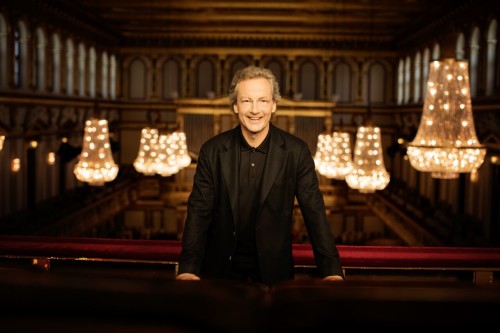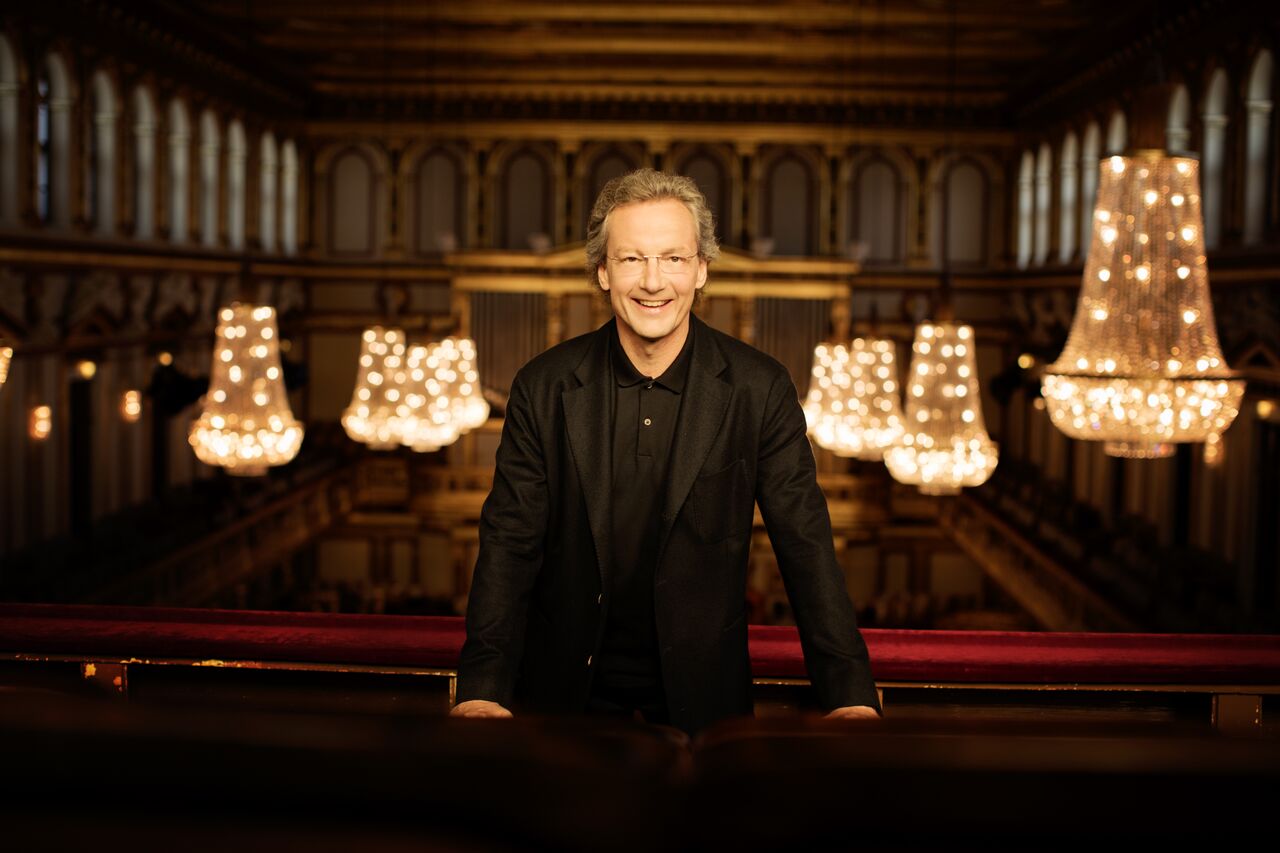 Austria Dvořák, Brahms, Wagner: Volkhard Steude (Violin), Peter Somodari (cello), Wiener Philharmoniker / Franz Welser-Möst (conductor). Grosser Musikvereinssaal, Vienna, 8.11.2018. (JPr)
Austria Dvořák, Brahms, Wagner: Volkhard Steude (Violin), Peter Somodari (cello), Wiener Philharmoniker / Franz Welser-Möst (conductor). Grosser Musikvereinssaal, Vienna, 8.11.2018. (JPr)

Dvořák – Carnival Overture, Op.92
Brahms – Double Concerto for violin, cello and orchestra in A minor, Op.102
Wagner – Morgendämmerung, Siegfrieds Rheinfahrt, Siegfrieds Tod und Trauermarsch, Schlussszene from Götterdämmerung
A first, an absolute first! After travelling back and forth to Vienna for over fifty years (if I include trips with my parents as a child) this was my first concert in the Grosser Saal (Great Hall) of Vienna’s Musikverein, familiar around the world from the annual concert broadcast live that is a must-see event for me on the first day of each new year. The performance begins before you enter the auditorium as it seems the cloakroom attendants cannot open their section until exactly thirty minutes before the start of the concert: to see them frequently sneaking a peek through or under their curtains to see what the clock showed made the wait pass very amusingly!
Although I have toured the nineteenth-century Musikverein briefly some years ago, a wait of more than half a century to sit in the ornately gilded hall with its impressive acoustics, prominent organ, frescoed ceiling, chandeliers, statues, boxes, walls – well just everything – that seems the near-fantasy setting for an orchestral concert was well worth it. Particularly if that orchestra is the Vienna Philharmonic performing Dvořák, Brahms and Wagner under Franz Welser-Möst, the Austrian conductor who is currently the music director of the Cleveland Orchestra.
My only surprise on entering the hall was to see members of the orchestra – mainly woodwind, brass and percussion – already on the platform going through the music. In the most ordered of cities I expected they would all enter en masse just before the starting time of the concert, which is what the strings alone did. The Vienna Philharmonic were on rampant form throughout Dvořák’s 1891 Carnival Overture that the composer described as: ‘The lonely, contemplative wanderer reaches the city at nightfall, where a carnival is in full swing’. With volume and energy levels at their highest from the players, Welser-Möst imposed an irresistible rhythmic grip on the music that brought the audience to the edge of their seats during a helter-skelter performance from the first notes of the joyous festive music until the coda.
Although there were individual moments for soloists to shine, the boisterous Carnival Overture is mainly an ensemble work, however it was Brahms’s Double Concerto for violin, cello and orchestra that brought concertmaster Volkhard Steude (violin) and cellist Peter Somodari to the fore. Brahms’s dedication on his 1887 Double Concerto read: ‘To him for whom it was written’. Him was his frequent collaborator Joseph Joachim for whom Brahms had written his Violin Concerto. This was a conciliatory gesture after Brahms had sided with Joachim’s wife Amalie in a divorce dispute three years earlier and a rift was created in their friendship. It is no coincidence that Brahms uses the musical motif A-E-F in this concerto as it is a permutation of F-A-E, Joachim’s personal motto, Frei aber einsam (‘Free but lonely’) and that in the first movement he references a violin work by Giovanni Battista Viotti, one of Joachim’s favourite pieces.
This Double Concerto in three movements (fast-slow-fast) represents Brahms at his happiest and most tuneful. From Steude and Somodari there was a biting attack where necessary but mostly they played the opening Allegro with a caressing silken tone. They then revealed the gloriously expansive melody of the slow movement (Andante) through their exquisite phrasing. The Vivace non troppo finale was lively and colourful, with their tempo choices as judicious here as throughout the entire work. Franz Welser-Möst did not need to be as energetic with his baton as he was with Dvořák, but he was no less exacting of the reduced number of players before him whose warm sound and spirited performance impeccably showcased the soloists. As an additional treat Steude and Somodari played an arrangement for violin and cello by Johan Halvorsen of a Handel Passacaglia (a set of variations from his Harpsichord Suite No.7). This again was played superbly with a self-evident sense of rapport between the soloists who drew the best from each other.
In a recent review of a concert – on a less grand scale – of excerpts from Wagner’s Götterdämmerung (click here) I considered the ‘bleeding chunks’ problem and – not for the first time – wrote how they usually begin ‘with a quick glimpse of “Dawn” and snatches of the duet between Siegfried and Brünnhilde before he sets off – seemingly on a speedboat – down the Rhine!’ On that occasion a remarkable new arrangement smoothed everything out but here in Vienna – and in the very concert hall where in March 1875 Wagner himself conducted music from Götterdämmerung for the first time in public – it was the familiar extracts we heard. Overall the Vienna Philharmonic was as consummate in Wagner as I guess it is in all it plays, yet it was a surprise to hear that the soloist for Siegfried’s horn call (during the ‘Rhine Journey’) found it no easier than others do. The music barely touched down at the Gibichung Hall long enough before we had the familiar ‘Siegfried’s Death and Funeral Music’ and it was not much longer before it was all over despite the final section being described as the ‘Schussszene’. Maybe had it been all of the ‘Immolation Scene’ – and with a singer – it would done more justice to Götterdämmerung, but it all began at Brünnhilde’s ‘Fliegt heim, ihr Raben!’ and we reached an incandescent end all too quickly. I did hear voices, though they were only in my head as I recalled the great Siegfrieds and Brünnhildes I have heard over the last four decades.
All was forgiven for the quality of the playing from the quiet ‘Dawn’ opening to Brünnhilde riding into the flames before the redemptive ending. Throughout the brass howled and growled excitingly, and the percussionists enthusiastically brought thudding power and impressive volume to a memorable performance of the ‘Funeral Music’. The Vienna Philharmonic’s woodwinds and horns – the horn call notwithstanding – sounded as true and as perfectly blended as expected. Welser-Möst concentrated on interpretative broadness and was not content to let any of these orchestral showpieces linger very much and I doubt whether any would have been played like that in the opera house. As the visceral excitement of the fearsome fortissimos of the final scene ebbed away I longed to hear the Wagner all over again.
Jim Pritchard
For more about what is on at the Musikverein click here.
